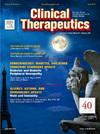Evaluation of Dexmedetomidine Withdrawal and Management After Prolonged Infusion
IF 3.6
4区 医学
Q2 PHARMACOLOGY & PHARMACY
引用次数: 0
Abstract
Purpose
Dexmedetomidine is often used for longer than its labeled indication of 24 hours, raising concerns for potential withdrawal. Data are limited regarding this syndrome in adult patients. This study aimed to further characterize dexmedetomidine withdrawal in critically ill adult patients after prolonged use.
Methods
This was an institutional review board–exempt, single-center, retrospective chart review conducted at a tertiary academic medical center. Adult intensive care unit (ICU) patients on dexmedetomidine for ≥72 hours in 2019 were screened for inclusion. Exclusion criteria were interruption of dexmedetomidine for >6 hours, indications for dexmedetomidine other than sedation, or patients with neurological or burn injury. The major end point was the incidence of dexmedetomidine withdrawal, defined as meeting ≥2 of the following criteria within 24 hours of discontinuation: newly positive Confusion Assessment Method for ICU, Richmond Agitation Sedation Scale score of ≥+2, hypertension, and tachycardia. Minor end points were incidence of individual withdrawal signs as previously described, additional sedatives or antipsychotics required, dose and duration of dexmedetomidine infusion, length of ventilation, ICU and hospital length of stay, and new onset of the following: fever, vomiting, loose stools/diarrhea, diaphoresis, or seizure.
Findings
Of the 152 patients included, dexmedetomidine withdrawal occurred in 54 patients (35.5%). Rebound hypertension was the most common withdrawal sign (47 patients [87.0%]). In the withdrawal group, significantly more patients required additional β-blockers (29 [53.7%] vs 10 [10.2%]; P < 0.01), were reinitiated on dexmedetomidine (16 [29.6%] vs 10 [10.2%]; P < 0.01), and required a start or increased dose of clonidine (6 [11.1%] vs 3 [3.1%]; P = 0.04). There was no significant difference in the cumulative dose or duration of dexmedetomidine between the groups. Length of ventilation was longer in the withdrawal group (171 hours [83.7–280.8 hours] vs 159 hours [149.0–335.7 hours]; P < 0.01), but there was no difference in ICU or hospital length of stay.
Implications
Prolonged use of dexmedetomidine was associated with withdrawal syndrome in 35.5% of patients in our study. Larger trials are needed to confirm the risk factors for dexmedetomidine withdrawal and identify measures to prevent withdrawal.
评估右美托咪定长期输注后的戒断和管理。
目的:右美托咪定的使用时间通常超过其标注的 24 小时适应症,这引发了对潜在戒断的担忧。有关成人患者出现这种综合征的数据十分有限。本研究旨在进一步了解成年重症患者长期使用右美托咪定后出现戒断的特点:这是一项经机构审查委员会批准的单中心回顾性病历审查,在一家三级学术医疗中心进行。筛选2019年使用右美托咪定≥72小时的成人重症监护病房(ICU)患者纳入研究。排除标准为右美托咪定中断时间>6小时、右美托咪定除镇静外的适应症、神经系统或烧伤患者。主要终点是右美托咪定戒断的发生率,定义为在停药后24小时内符合以下标准中的≥2项:ICU昏迷评估法新阳性、里士满躁动镇静量表评分≥+2、高血压和心动过速。次要终点为:如前所述的个别戒断症状的发生率、所需额外镇静剂或抗精神病药物、右美托咪定输注剂量和持续时间、通气时间、重症监护室和住院时间,以及新出现的以下症状:发热、呕吐、便稀/腹泻、全身湿疹或癫痫发作:在纳入的 152 名患者中,54 名患者(35.5%)出现右美托咪定停药。反跳性高血压是最常见的停药征兆(47 名患者 [87.0%])。在停药组中,需要额外使用β-受体阻滞剂(29 [53.7%] vs 10 [10.2%];P < 0.01)、重新开始使用右美托咪定(16 [29.6%] vs 10 [10.2%];P < 0.01)以及需要开始或增加氯尼替胺剂量(6 [11.1%] vs 3 [3.1%];P = 0.04)的患者明显增多。两组间右美托咪定的累积剂量或持续时间没有明显差异。停药组的通气时间更长(171 小时 [83.7-280.8 小时] vs 159 小时 [149.0-335.7 小时];P < 0.01),但重症监护室或住院时间没有差异:启示:在我们的研究中,35.5%的患者长期使用右美托咪定会导致戒断综合征。需要进行更大规模的试验来确认右美托咪定戒断的风险因素,并确定预防戒断的措施。
本文章由计算机程序翻译,如有差异,请以英文原文为准。
求助全文
约1分钟内获得全文
求助全文
来源期刊

Clinical therapeutics
医学-药学
CiteScore
6.00
自引率
3.10%
发文量
154
审稿时长
9 weeks
期刊介绍:
Clinical Therapeutics provides peer-reviewed, rapid publication of recent developments in drug and other therapies as well as in diagnostics, pharmacoeconomics, health policy, treatment outcomes, and innovations in drug and biologics research. In addition Clinical Therapeutics features updates on specific topics collated by expert Topic Editors. Clinical Therapeutics is read by a large international audience of scientists and clinicians in a variety of research, academic, and clinical practice settings. Articles are indexed by all major biomedical abstracting databases.
 求助内容:
求助内容: 应助结果提醒方式:
应助结果提醒方式:


